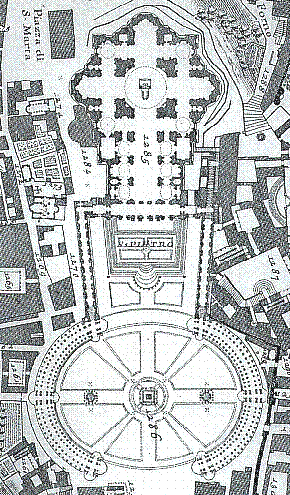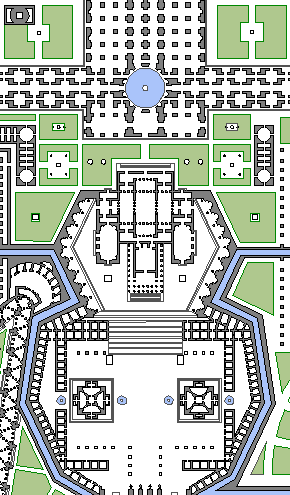7 November 312
Constantine already has it in his head that Rome is not going to be his capital city. His mother and his mother-in-law can do as they please because he has other plans in mind.
7 November 1778 Saturday
 
7 November 1812 Saturday

Morning cloudy, ..... for rain. I packed up some articles for Capt. Marshall. Dined at SLís and PM came home. Wind NE occasionally dropping some rain. Roads very wet ..... .... cut by the market wagons.
7 November 1999
Encyclopedia Ichnographica
As it stands now, my ongoing investigation and redrawing of the Ichnographia has led to the 'discovery' of a whole new aspect of Piranesi's work that so far no one else has found, namely that the large plan of the Campo Marzio is a readable narrative of Ancient Rome's political and architectural history--but in order to grasp this delineated 'text' one must 'read' in unison the individual plans, the plans in relationship to each other, the plans in relation to where the actual buildings really were, and (this is perhaps the most important) the Latin labels Piranesi gives to each plan.
7 November 2000
Baroque Intuition?
Alex states:
When in my previous post I rhetorically asked who had 'invented' or 'designed' the Baroque, I was somewhat shocked to see candidates actually being proposed for this mythical position.
Steve replies:
When I proposed Michelangelo as a place to look for the 'beginnings' [Alex's original rhetorical only asked about who 'designed'], I also particularly called out Michelangelo's fortification designs for Florence. In the almost two weeks since then I did some further reading/research on the fortifications. I read what Ackerman and Argan/Contradi offer, and I was surprised to learn that fortifications by Michelangelo were indeed executed, but in an impermanent fashion--packed dirt and straw--and did not stand up well to attack. Their only record today are Michelangelo's design sketches. Also surprising were the dates of the designs: 1528-29, i.e., before Michelangelo's mature [architectural] works in Rome. I was surprised because of the relative earliness within the 16th century--"is it possible that there were Baroque 'beginnings' so early in the 16th century?"
I also took a more careful look at Michelangelo's fortification designs, of which there are several dozen drawings, and, in purely design terms, they are indeed extremely (i.e., at the beginning of a alpha-omega polarity) Baroque.
I then looked through The Timetables of History, a reference book that chronologically lists events year by year. There I found that the Sack of Rome occurred in 1527 and is "referred to as 'End of the Renaissance'." Now I was very intrigued by what was going on politically and socially in Italy at that time, and did further reading throughout Encyclopedia Britannica. For example, the Marxist view of the end of the Renaissance calls out Luther's "protests" of 1517. In any case, very unstable times for the Roman Catholic Church, 'the' Establishment.
History is both a collective and an individual collection of occurrences, especially in terms of design.
On 27 October 2000, I posted a "Baroque ending"--a double play by Bernini first performed in 1637, again a very early date and closer to what is generally termed the beginning of the Baroque. In The Timetables of History, I found that Poussin painted The Arcadian Shepherds (Et in Arcadia Ego) in 1638 and in Rome! This surprised me because I always viewed that particular painting as holding strong Romantic and Neo-Classical evocations--again a date much earlier than I expected.
I stated that Bernini's play capsulized Western cultures new bifurcation, so what was this new split? The fact that the Roman Catholic Church was no longer 'believed' to be the harbinger of the 'true' reality throughout Europe is now on one side and the Roman Catholic Church's now mostly violent (albeit sanctimonious) insistence that they were still the 'true' reality is on the other side. Europe, between roughly 1528 and 1637 was very much a bloody double theater.
The above is only a very basic outline of a (new) thesis (for me) that the essential Baroque occurred between 1528 and 1637. There are many more factors to consider and research, e.g., the rise of French political and cultural 'power' during the same period. I realize that the [so-called?] Mannerist period occurred within the early half of what I now propose as the Baroque's essential 'period', but I also propose that architecture after 1637 is reenactionary, specifically reenacting the Baroque 'play'.
ps
Does it help to be 'baroque' when analyzing the Baroque?
Re: two for the road
I like what you say about not recalling "another film that, structurally, collages space and time in that particular way." Two for the Road does indeed collage space and time, but I was never sure how unique its particular method of cinematically doing so might be. In any case, it's worth noting that the collage here very effectively relates a narrative, specifically a 'modern' life narrative. Is the film's "collage of space and time" a (romantic) reflection (i.e., mirror) of modern life itself?
7 November 2022 Monday
. . . . . .
|